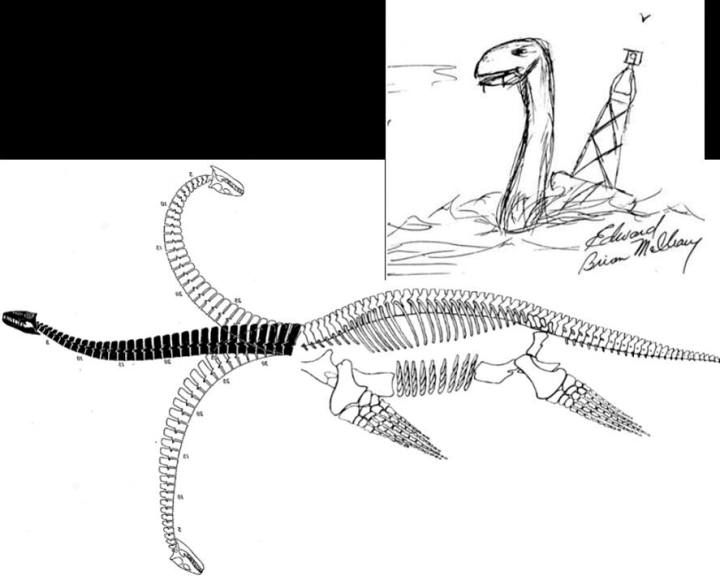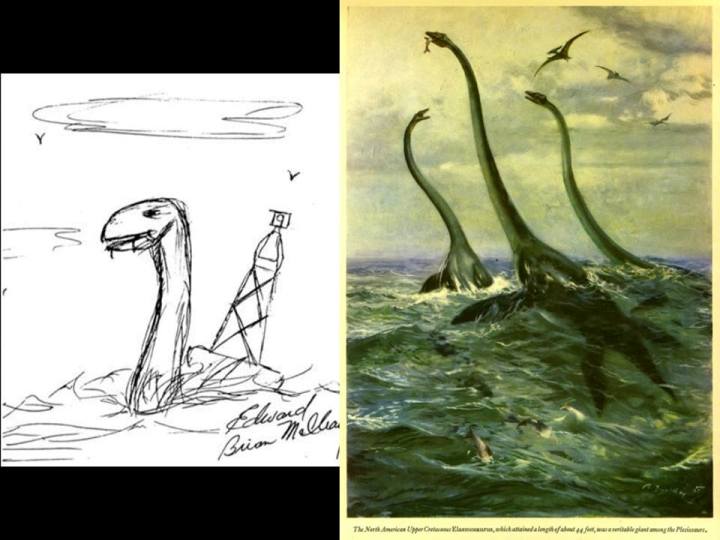
February 21, 2014

The May 1965 issue of FATE magazine featured the story “My Escape from a Sea Monster”, written by one Edward Brian McCleary. This was his supposedly true eyewitness account of himself and 4 friends being attacked by a “sea monster” of some sort off the coast of Pensacola, Florida on March 24, 1962. His four friends were allegedly either killed by this thing or drowned, McCleary being the only survivor. Previous Cryptomundo posts about this incident are to be found here: Death by Sea Serpent? and here: What’s Eating You? Florida’s Hungry Sea Serpent Revisited. McCleary and his friends were supposedly attempting to dive on the wreck of a ship called the U.S.S. Massachusetts and became lost in a fog when this “monster” attacked them. I suggest you read those before proceeding further.

On Dec. 30, 1947, the cruise ship Santa Clara allegedly collided with an unknown sea monster resembling the above drawing approximately 118 miles out to sea from Lookout Point, North Carolina. Perhaps this was an encounter with something similar to McCleary’s allleged monster, perhaps not.
Assuming McCleary’s monster was real and might have been a plesiosaur, problems with the head and neck posture may arise.

It is generally believed that the angle of the zygapophyses of most plesiosaur cervical vertebrae and how they articulated with one another would have inhibited vertical flexure in most plesiosaur necks and is the reason that most plesiosaurs would have been incapable of assuming a swan-like neck posture typical of many “long-necked sea monster” sightings.
There seems to be reason to believe also that the head would not have been articulated at a 90 degree angle to the neck, though I have not seen this explicitly explained in the scientific literature. However, one juvenile leptocleidine plesiosaur from the lower Cretaceous of Australia had steeply angled zygapophyses in it’s cervical vertebrae that would have seemingly facilitated vertical neck flexure. Perhaps an evolved modern plesiosaur might have similar adaptations.
Presumably, a long necked giant pinniped would not have these problems but a whole new set of problems might arise from the constraint of 6 or 7 cervical vertebrae common to mammals stretched out to such a neck length possibly compromising aquatic locomotor function and balance.
One way of getting around this problem of the appearance of a vertical neck standing out of the water relative to plesiosaurs is to have the animal hanging vertically in the water column.

Whatever may ultimately be behind the McCleary incident and similar reports, the anecdotal evidence is certainly compelling enough to encourage us to keep looking. For the “we can’t find it so it does not exist” school, a whole host of common place animals, inanimate objects, water and atmospheric distortions, the power of suggestion and deliberate fraud will constitute the bulk of it. Critics of the prehistoric survivor paradigm would do well to remember that there are a whole host of supposedly “reworked” and out-of-place plesiosaur fossils spanning from the Paleocene to the Pleistocene periods that have not been radiometrically dated nor rare earth element tested as far as I can determine.
About Scott Mardis
Scott Mardis has been an active field investigator of the Lake Champlain “Monster” since 1992. He is a former sustaining member of the defunct International Society of Cryptozoology and a former volunteer worker in the Vertebrate Paleontology Dept. of the Philadelphia Academy of Natural Sciences (1990-1992). He co-authored a scientific abstract about the Lake Champlain hydrophone sounds for the Acoustical Society of America in 2010. He currently lives in Bradenton, Florida.
Filed under Bigfoot Report, Cryptozoologists, Cryptozoology, Evidence, Eyewitness Accounts, Giant Cryptid Reptiles, Sea Monsters, Sea Serpents